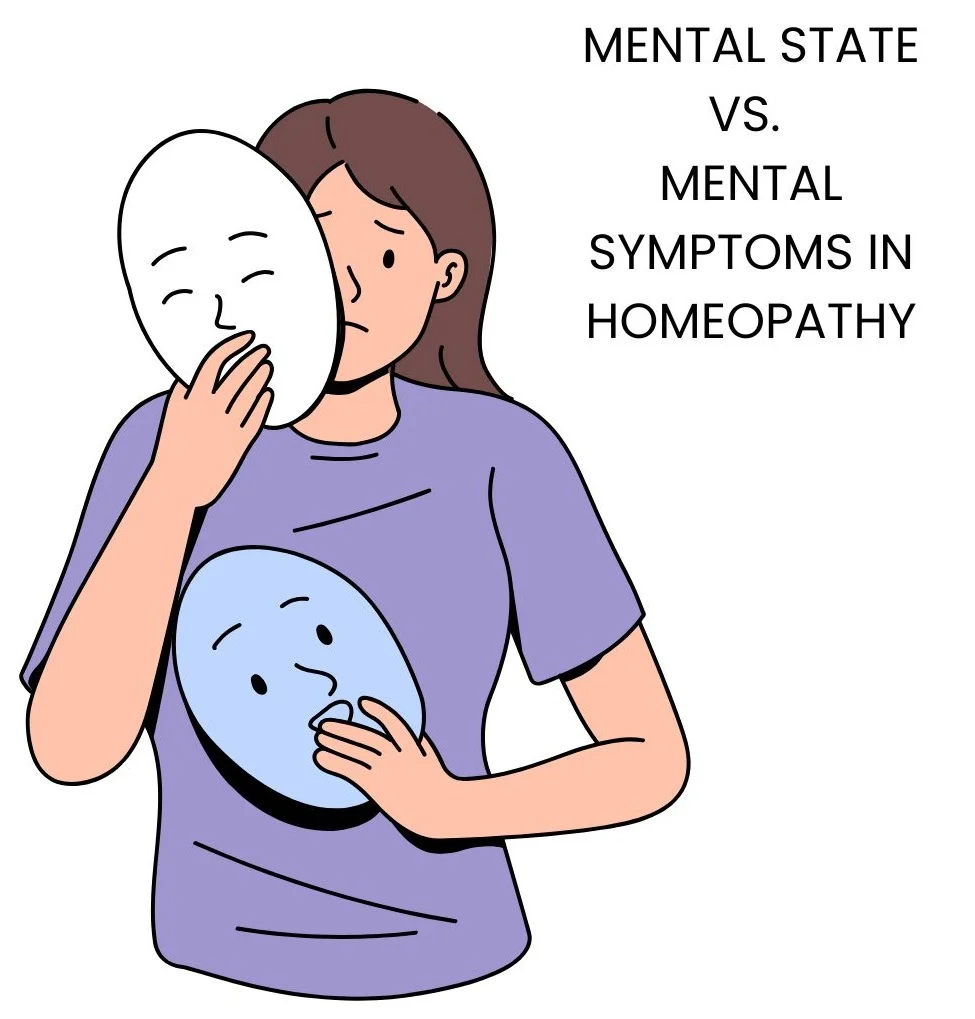If you’re a homeopath struggling with confusing cases, vague mental rubrics, or repeated remedy failures — chances are you’re not distinguishing between a patient’s mental state and mental symptoms.
This subtle but powerful difference is the heart of accurate case analysis.
Once you master it, you’ll stop prescribing based on superficial signs and begin to see the core of the person, not just their symptoms.
This post explains this crucial distinction in a way you will never forget.
HOW TO IDENTIFY MENTAL STATE DURING CASE TAKING IN HOMEOPATHY
HOW TO IDENTIFY MENTAL SYMPTOMS DURING CASE TAKING IN HOMEOPATHY

Table of Contents
Toggle1. What is the Mental State in Homeopathy?
The mental state refers to the inner climate of a person.
It’s not just how the person feels today — it’s how they have always been, how they interpret life, how they respond to pain, fear, loss, and stress.
t’s consistent, chronic, and characteristic.
Think of it as the emotional posture the patient stands in — their perception of the world and themselves.
Mental State Includes
- Their emotional tone over years (not days)
- Reaction patterns (Do they fight, freeze, run?)
- Core coping mechanisms (Suppression, denial, withdrawal)
- Deep fears or needs (Fear of abandonment, need for control)
- Overall personality traits (Reserved, bossy, timid, cheerful, overly responsible, etc.)
Examples
- A woman who has been silently grieving for years and hides her emotions—this is a Natrum Muriaticum state.
- A man who feels like a failure even though he is successful, always seeks approval—this may be Lycopodium.
This is what — the deepest layer of experience that guides you to the constitutional remedy.
2. What are Mental Symptoms in Homeopathy?
Mental symptoms are observable expressions — specific, often isolated mental disturbances that may or may not be linked to the deeper personality.
They are like signposts, not the road.
They show up as:
- Delusions (“I am being followed” – Stramonium)
- Fears (fear of thunder, ghosts, death – Phosphorus, Aconite)
- Obsessions or compulsions (washes hands repeatedly – Syphilinum)
- Hallucinations
- Irrational behaviours (laughing at sad news – Ignatia)
These are picked up as rubrics in repertory. They are important, but they’re only parts of the whole, not the centre of the case.
3. Why the Confusion Happens
Most beginner doctors:
- Jump to mental rubrics too quickly.
- Focus only on peculiar symptoms and forget the overall pattern.
- Fail to differentiate between a transient emotional response and a chronic emotional constitution.
Result?
You prescribe a remedy that fits the symptom but misses the person.
Example
A patient says they fear being alone. If you focus only on the fear, you might choose Pulsatilla.
But what if the patient is actually a self-contained, sarcastic person who just felt vulnerable recently due to a breakup? That’s not Pulsatilla. You missed the mental state.
4. How to Identify Mental State During Case Taking
To uncover the mental state:
- Ask about long-term patterns, not temporary moods.
- Explore reactions to life events.
- Go deep into childhood, relationships, dreams, and coping strategies.
- Use Rajan Sankaran’s method of “What happens to you when…”
Example
“What happens inside when someone ignores you?”
You’re looking for how they process and feel, not just what they do.
Let them speak. Let them reflect. Don’t rush.
Watch for themes
- Control, grief, performance, abandonment, betrayal, injustice, fear, etc.
These themes will point you to the core mental state and eventually to the right remedy family or kingdom (mineral, plant, animal, etc.).
5. How to Identify Mental Symptoms
During case-taking, mental symptoms often appear when:
- A patient describes irrational fears, odd dreams, or hallucinations.
- There are clear rubrics like “talks to imaginary people,” “fear of dogs,” or “delusion he is God.”
- You notice mood swings, obsessive behaviors, or intense phobias that are peculiar or exaggerated.
These are important for acute prescribing, for differentiating between two close remedies, or to match an acute phase of a chronic case.
6. When to Use Which? Mental State vs. Mental Symptoms
Golden Rule
Mental State = WHO the patient is.
Mental Symptoms = WHAT the patient is experiencing.
7. Remedies and Their Mental States vs. Symptoms (Illustrated)
Let’s look at a few remedies to make the difference even clearer:
- Mental State: Reserved, emotionally closed, sensitive to rejection, self-reliant.
- Mental Symptoms: Weeps alone, dreams of robbers, fear of thunder.
- Mental State: Jealous, suspicious, loquacious, intense.
- Mental Symptoms: Delusion that they are being poisoned, talks constantly, anger on waking.
- Mental State: Insecure, needs control, anxious about health, perfectionist.
- Mental Symptoms: Fear of death at night, restlessness, cannot stay in one place.
By learning to distinguish the state from the symptom, your remedy selection becomes precise and deeply curative.
8. Why This Distinction is Life-Changing for a Homeopath
Once you grasp this:
- You’ll stop giving Pulsatilla just because someone cries.
- You’ll find Silicea behind quiet anxiety.
- You’ll unlock long-stuck cases.
- You’ll feel more confident in chronic cases.
This is what separates a beginner from a confident prescriber.
Conclusion: Your Action Plan
- During every case-taking, first seek the mental state.
- Use mental symptoms as supporting evidence — not the base.
- Read deeply about constitutional states of major remedies.
- Practice listening beyond symptoms — into the patient’s story.
- Journal your cases and notice where you missed the state vs. symptom.
You’ll soon discover: your results will transform.
Remember: In homeopathy, we don’t just treat disease. We treat human beings with depth.
